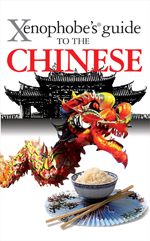|
|
|
The Xenophobe's Guide
to the Chinese
by Zhu Song
A guide to understanding the Chinese that
provides an irreverent look at the oriental outlook of
the largest nation on earth.
NOW Available online
as an eBook.
See button below right to sample.
| Inveterate
inventors |
| The Chinese are
inordinately proud of having invented, among a
whole host of other things, the compass (without
which the world would have got lost), paper
(without which books would not exist), the
printing press (ditto), porcelain (no pretty
matching chinaware), silk (no decadence), pasta
(what would the Italians eat?), the wheelbarrow
(how would civilisation have fared without it?)
and the bristle toothbrush. |
| How now re
nao |
| To be re nao, or
hot and noisy, is extremely desirable. This is
why the Chinese invented fireworks – life as
they knew it simply wasn’t hot and noisy enough.
This is also why the ear-splitting and
body-swaggering lion dance is Chinese, rather
than the comparatively tranquil ballet. Can
anyone who has witnessed the cacophonous
spectacle that is Peking opera doubt its
quintessential Chinese-ness? Festivals call for
the loud clanging of cymbals and tooting of
horns, and traditional weddings are as red and
raucous as church weddings are white and hushed.
Re nao represents life and vigour. |
| Slip of the
tongue? |
| One of the worst insults
for a Chinese is to be called a ‘banana’ –
yellow on the outside, white on the inside. |
| Yes, no, maybe? |
| The words ‘Yes’ and ‘No’,
crucial in other languages, are not deemed so in
Chinese. Instead the answer depends on the verb
used in the question. The reply to "Is she your
daughter?" is either "Is" or "Is not", and to
"Have you been to Disneyland?" is "Been" or "Not
been". This may seem simple enough, but beware
when asking a negative question: "That bag isn’t
yours, is it?" will confusingly elicit "Is, it
isn’t" (yes it isn’t mine). |
| Character flaw |
| Chinese is one of the few
languages where you can very easily be
illiterate even if you are fluent. The
characters are notoriously hard to remember.
Learning them is a matter of rote and repetition
until etched onto the brain, and requires the
daily exercise of the national mantra: ‘practice
makes perfect’. |
| The Xenophobe's Guide to the
Chinese is exactly what it claims to be on its
back cover, 'an irreverent look at the beliefs
and foibles of (the Chinese), almost guaranteed
to cure xenophobia. |
|
Catherine McKinley, China in
Focus
|
| The book proceeds like a meal of
dim sum, a succession of piquant little items,
light but nourishing. The author is succinctly
illuminating on the Chinese peculiarities likely
to be relevant to a foreigner - the remarks on
'modesty' should be read weekly by Western
linguists. |
|
The Spectator
|
| Xenophobe's of the world unite.
There is hope that through these small but
observant books you may be able to overcome
ingrained prejudice. |
|
Gibraltar Chronicle
|
|
Nationalism &
Identity
Character
Language & Conversation
Attitudes and Values
Behaviour
Manners
Leisure & Pleasure
Sense of Humour
Culture
Eating & Drinking
Custom & Tradition
Health & Hygiene
Systems
|
|
|

| Author: Song, Zhu |
| Format: 96 pages,
pb |
|
Published: 1/9/2010
|
| Updated: |
| Price: £4.99 |
| ISBN: 978-1-906042-26-4 |
| Online eBook. Click on
button below to sample. |

|


